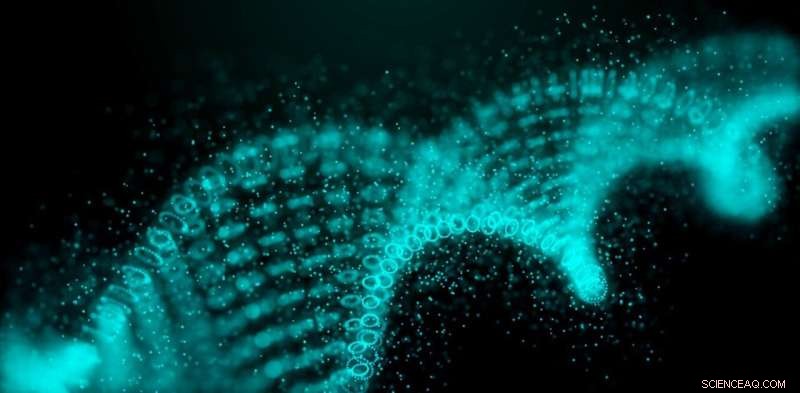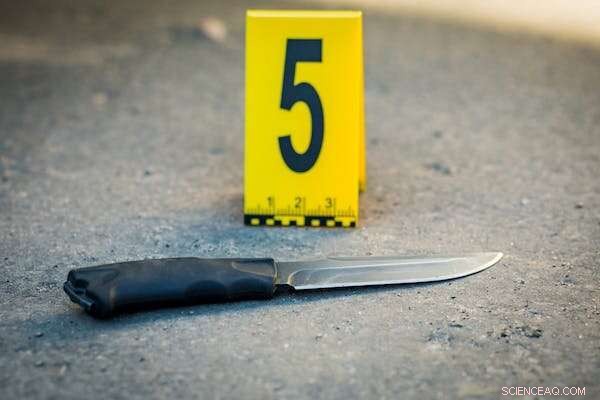
Kredit:thinkhubstudio/Shutterstock
DNA-profilering är ofta i nyheterna. Allmänt intresse väcks när DNA används för att identifiera en misstänkt eller mänskliga kvarlevor, eller löser ett kallt fall som verkar nästan glömt.
Mycket ibland är det i media när processen inte fungerar som den ska.
Så vad är DNA-profilering och hur fungerar det – och varför fungerar det ibland inte?
En kort historia av DNA-profilering
DNA-profilering, som den har varit känd sedan 1994, har använts i det straffrättsliga systemet sedan slutet av 1980-talet och kallades ursprungligen "DNA-fingeravtryck."
DNA:t i varje människa är väldigt likt - upp till 99,9% identiskt, faktiskt. Men konstigt nog är cirka 98 % av DNA:t i våra celler inte genrelaterat (d.v.s. har ingen känd funktion).
Detta icke-kodande DNA består till stor del av sekvenser av de fyra baserna som utgör DNA:t i varje cell.
Men av okända skäl upprepas vissa avsnitt av sekvensen:ett exempel är TCTATCTATCTATCTATCTA där sekvensen TCTA upprepas fem gånger. Även om antalet gånger denna DNA-sekvens upprepas är konstant inom en person, kan det variera mellan människor. En person kan ha 5 repetitioner men en annan 6, eller 7 eller 8.
Det finns ett stort antal varianter och alla människor faller in i en av dem. Detekteringen av dessa upprepningar är grunden för modern DNA-profilering. En DNA-profil är en lista med siffror, baserad på de upprepade sekvenser vi alla har.
Användningen av dessa korta upprepningssekvenser (den tekniska termen är "short tandem repeat" eller STR) började 1994 när UK Forensic Science Service identifierade fyra av dessa regioner. Chansen att två personer som tagits slumpmässigt i befolkningen skulle dela samma upprepade siffror i dessa fyra regioner var cirka 1 på 50 000.
Nu har antalet kända upprepade sekvenser utökats kraftigt, med det senaste testet som tittar på 24 STR-regioner. Att använda alla de kända STR-regionerna resulterar i en oändligt liten sannolikhet att två slumpmässiga personer har samma DNA-profil. And herein lies the power of DNA profiling.
How is DNA profiling performed?
The repeat sequence will be the same in every cell within a person—thus, the DNA profile from a blood sample will be the same as from a plucked hair, inside a tooth, saliva, or skin. It also means a DNA profile will not in itself indicate from what type of tissue it originated.
Consider a knife alleged to be integral to an investigation. A question might be "who held the knife"? A swab (cotton or nylon) will be moistened and rubbed over the handle to collect any cells present.

Swabbing an item left at a crime scene can easily yield enough cells to generate a DNA profile. Credit:Fuss Sergey/Shutterstock
The swab will then be placed in a tube containing a cocktail of chemicals that purifies the DNA from the rest of the cellular material—this is a highly automated process. The amount of DNA will then be quantified.
If there is sufficient DNA present, we can proceed to generate a DNA profile. The optimum amount of DNA needed to generate the profile is 500 picograms—this is really tiny and represents only 80 cells!
How foolproof is DNA profiling?
DNA profiling is highly sensitive, given it can work from only 80 cells. This is microscopic:the tiniest pinprick of blood holds thousands of blood cells.
Consider said knife—if it had been handled by two people, perhaps including a legitimate owner and a person of interest, yet only 80 cells are present, those 80 cells would not be from only one person but two. Hence there is now a less-than-optimal amount of DNA from either of the people, and the DNA profiling will be a mixture of the two.
Fortunately, there are several types of software to pull apart these mixed DNA profiles. However, the DNA profile might be incomplete (the term for this is "partial"); with less DNA data, there will be a reduced power to identify the person.
Worse still, there may be insufficient DNA to generate any meaningful DNA profile at all. If the sensitivity of the testing is pushed further, we might obtain a DNA profile from even a few cells. But this could implicate a person who may have held the knife innocently weeks prior to an alleged event; or be from someone who shook hands with another person who then held the knife.
This later event is called "indirect transfer" and is something to consider with such small amounts of DNA.
What can't DNA profiling do?
In forensics, using DNA means comparing a profile from a sample to a reference profile, such as taken from a witness, persons of interest, or criminal DNA databases.
By itself, a DNA profile is a set of numbers. The only thing we can figure out is whether the owner of the DNA has a Y-chromosome—that is, their biological sex is male.
A standard STR DNA profile does not indicate anything about the person's appearance, predisposition to any diseases, and very little about their ancestry.
Other types of DNA testing, such as ones used in genealogy, can be used to associate the DNA at a crime scene to potential genetic relatives of the person—but current standard STR DNA profiling will not link to anyone other that perhaps very close relatives—parents, offspring, or siblings.
DNA profiling has been, and will continue to be, an incredibly powerful forensic test to answer "whose biological material is this"? This is its tremendous strength. As to how and when that material got there, that's for different methods to sort out.